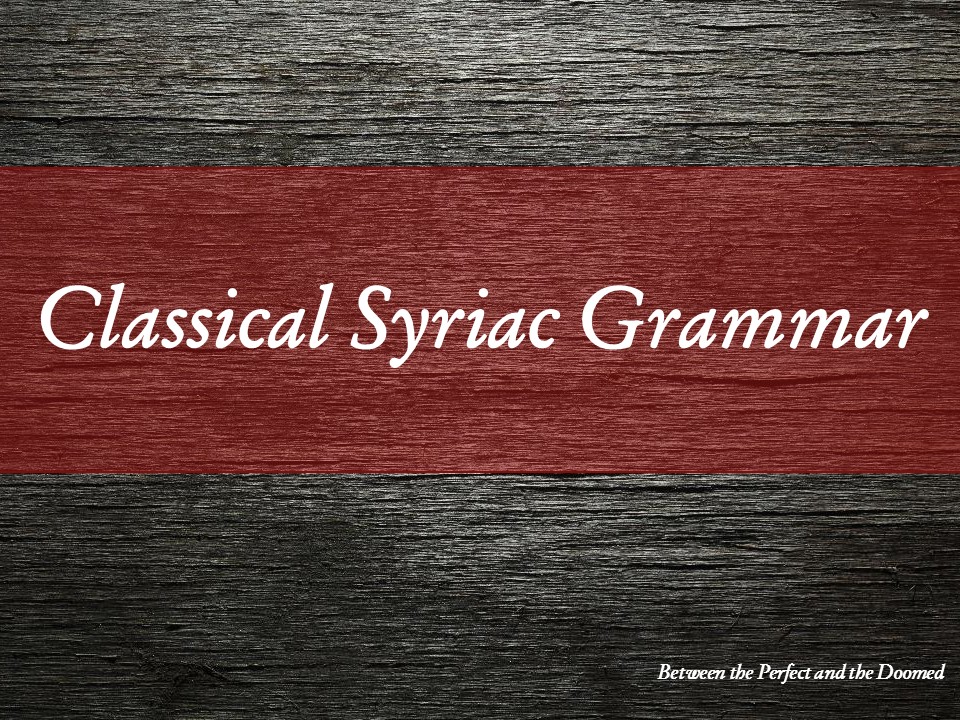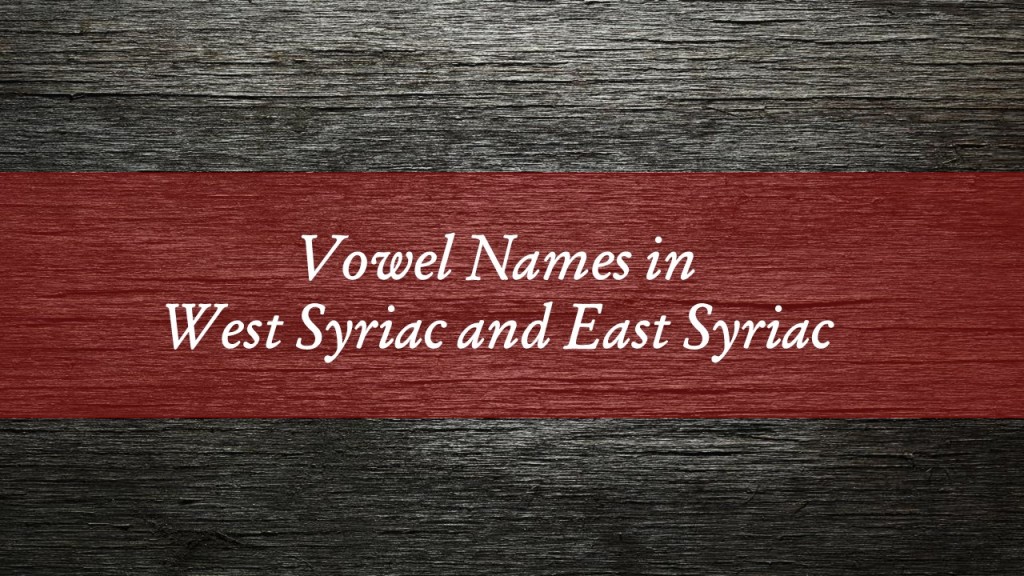This is a quick video I put together this morning. It’s the Lord’s Prayer in Classical Syriac using a modified East Syriac pronunciation. It’s the pronunciation used in the grammar I am currently writing. At some point, I will do a video with the Lord’s Prayer using a proper East Syriac pronunciation (or as close as I can get it!) and a separate one using a West Syriac pronunciation.
Syriac
The Punctuation of John 1:3-4 in the Syriac Peshitta
The punctuation of John 1:3-4 is a well-known problem in New Testament scholarship. The issue has to do with whether the final words of John 1:3 form the end of a sentence (NIV) or the beginning of a sentence that continues into John 1:4 (NRSVUE). We won’t solve the problem with this video. But we’ll see how the translator of the Gospel of John in the Syriac Peshitta understood these verses.
Vowel Names in West Syriac and East Syriac
A PDF version of this post with proper Syriac fonts can be found here: Vowel Names in West Syriac and East Syriac.
When learning Classical Syriac, it can sometimes be difficult to make sense of the names that are used for vowels in Classical Syriac. Part of the reason has to do with the fact that the names of vowels are pronounced somewhat differently in West Syriac compared to East Syriac. Another reason has to do with the fact that the names of some vowels in West Syriac are different from their names in East Syriac. But the primary reason has to do with the fact that some vowels in East Syriac have more than one name.
The purpose of this post is to compare the names of the vowels that are used in West Syriac and East Syriac and to clear up some of the confusion that can come because of the differing names that are used.
We can begin with the names of the vowels that are identical in West Syriac and East Syriac:[1]
| West Syriac | East Syriac | ||
| ptōḥō’ (ܰ) | a | ptāḥā’ (ܲ) | a |
| zqōpō’ (ܳ) | ō | zqāpā’ (ܵ) | ā |
| ḥbōṣō’ (ܺ) | ī | ḥbāṣā’ (ܼ) | ī |
As we can see in the chart, there are only three vowels in West Syriac and East Syriac that have identical names for the same vowels. The differences in the names of these vowels as well as the difference in pronunciation between the zqōpō’ () and the zqāpā’ () can be explained by the fact that the long a (ā) in Classical Syriac shifted to a long o (ō) in West Syriac (cf. Nöldeke §44). Once this shift in pronunciation is recognized, it is easy to recognize that the names of these vowels correspond with each other perfectly.
In some cases, however, the names of the vowels in West Syriac are simply different from the names that are used in East Syriac:[2]
| West Syriac | East Syriac | ||
| rbōṣō’ (ܶ) | e | zlāmā’ pšîqā’ (ܸ) | e |
| rbōṣō’ (ܶ) | e | zlāmā’ qašyā’ (ܹ) | ē |
| ‘ṣōṣō’ (ܽ) | u | rwāḥā’ (ܘܿ) | ō |
| ‘ṣōṣō’ (ܽ) | u | rbāṣā’ (ܘܼ) | ū |
Several points should be noted here. First, the rbōṣō’ in West Syriac corresponds to two separate vowels in East Syriac: the zlāmā’ pšîqā’ and the zlāmā’ qašyā’. Second, the ‘ṣōṣō’ in West Syriac corresponds to two separate vowels in East Syriac: the rwāḥā’ and the rbāṣā’. Third, the rbōṣō’ in West Syriac has the same name as the rbāṣā’ in West Syriac but represent different vowel sounds (e vs. ū). Finally, as was noted earlier, the names of the corresponding vowels are simply different from each other.
It should also be noted that some vowels used in East Syriac have more than one name. These alternative names correspond more closely with their equivalents in West Syriac:[3]
| West Syriac | East Syriac | ||
| rbōṣō’ (ܶ) | e | zlāmā’ pšîqā’ (ܸ) = rbāṣā’ ’arrīkā’ (ܸ) | e |
| rbōṣō’ (ܶ) | e | zlāmā’ qašyā’ (ܹ) = rbāṣā’ qašya’ (ܹ) = rbāṣā’ karyā’ (ܹ) | ē |
| ‘ṣōṣō’ (ܽ) | u | rwāḥā’ (ܘܿ) = ‘ṣāṣā’ rwīḥā’ (ܘܿ) | ō |
| ‘ṣōṣō’ (ܽ) | u | rbāṣā’ (ܘܼ) = ‘ṣāṣā’ ’āllīṣā’ (ܘܼ) | ū |
Note that the word ’arrīkā’ means “short,” the word qašyā’ means “hard,” the word karyā’ means “short,” the word rwīḥā’ means “wide,” and the word ’āllīṣā’ means “narrow” or “short in pronunciation”.[4] The reason why the East Syriac vowels have alternative names is because these vowel points were also sometimes used by West Syriac writers (e.g. Bar Hebraeus).[5] The transliterations for the alternative names have ā instead of ō simply for the sake of convention (i.e. when using the Estrangela script or the East Syriac script, the transliterations for East Syriac are used). However, these names would have been pronounced using the long ō. This explains why the alternative names correspond more closely with the names that are used in West Syriac.
So what names should you memorize when you are learning Classical Syriac? In an ideal world, it would be best to memorize all of the names. However, as you begin to study Classical Syriac, it is best to keep things as simple as possible. My recommendation is that if you are learning Classical Syriac using the West Syriac script, you should use the names that are used in West Syriac. However, if you are learning Classical Syriac using either the East Syriac script or the Estrangela script, you should use the names of the vowels that are used in East Syriac.
Mark Steven Francois
[1] Cf. Nöldeke §§ 8-9; Muraoka §4; Mingana §§14-33; Sokoloff (under each name); Payne Smith (under each name).
[2] Cf. Nöldeke §§ 8-9; Muraoka §4; Mingana §§14-33; Sokoloff (under each name); Payne Smith (under each name).
[3] Cf. Nöldeke §§ 8-9; Muraoka §4; Mingana §§14-33; Sokoloff (under each name); Payne Smith (under each name).
[4] Note that Muraoka has a typo and spells it ‘āllīṣā’. In Syriac it is spelled ܐܲܠܝܼܨܵܐ.
[5] See especially Mingana §24.
Verbal Patterns in Classical Syriac (Part 2)
I have added a new video to the Syriac Grammar page on this website. It deals with the functions of the Pe’al, the Pa”el, and the Af’el. Hope it is helpful.
Verbal Patterns in Classical Syriac (Part 1)
I’ve added a video to the Syriac Grammar page that introduces verbal patterns in Classical Syriac. The explanation in the video (like I mentioned way too many times!) is overly simple but it’s a good starting point to think about what we mean when we talk about verbal patterns. I will be adding another video shortly that goes into more detail about how the different verbal patterns actually function in Classical Syriac. I will also likely add a video about how to recognize verbal patterns when translating and how to look up the meanings in a dictionary. I hope it’s helpful!
Vowels in Classical Syriac
I’ve added a video to the Syriac Grammar page that introduces vowels in Classical Syriac, both in East Syriac and West Syriac. It can also be found here. First real video in over a year. Enjoy!
Classical Syriac: Memorizing the Pe’al, Pa”el, and Aph’el Perfect for Regular Verbs
I’ve added a video to the Syriac Grammar page with a song video that will (hopefully!) make it easier to memorize the paradigm for the Pe’al, Pa”el, and Aph’el Perfect for regular verbs. It can also be found here below. Enjoy!
Syriac Alphabet Tracing Sheet – West Syriac (Serto)

I have just added a tracing sheet for the Syriac alphabet in the West Syriac (Serto) script (see below). This script is an important script to learn since several important resources, most notably Payne Smith’s A Compendious Syriac Dictionary, are written in the West Syriac (Serto) script. My free online grammar of Classical Syriac, including resources similar to this, can be found at https://markfrancois.wordpress.com/syriac-grammar/.
Practice Sheet 1.8 – Alphabet Tracing Sheet – West Syriac (Serto)
The Classical Syriac Alphabet: The Names of the Letters and the Sounds They Make
This video gives the names of the letters of the Syriac alphabet in the Estrangela script and how they are pronounced. The pronunciation of the names of these letters and the sounds they make will vary depending on whether or not we’re using a West Syriac pronunciation or an East Syriac pronunciation. The pronunciation used in this video is close to the pronunciation used in East Syriac, though it reflects a pronunciation that would have been used at an earlier stage of the language. In other words, the pronunciation used here reflects the pronunciation that is generally given in fully vocalized East Syriac texts. For help learning how to write each letter, look for the tracing pages at https://markfrancois.wordpress.com/syriac-grammar/. Enjoy!
Syriac Grammar Chapter 7 Now Online

I have just posted chapter 7 of my free online Classical Syriac Grammar. It covers pronominal suffixes on nouns, relative clauses, and anticipatory pronominal suffixes. It can be found at https://markfrancois.wordpress.com/syriac-grammar/.
Exercises will be added shortly. Enjoy!
